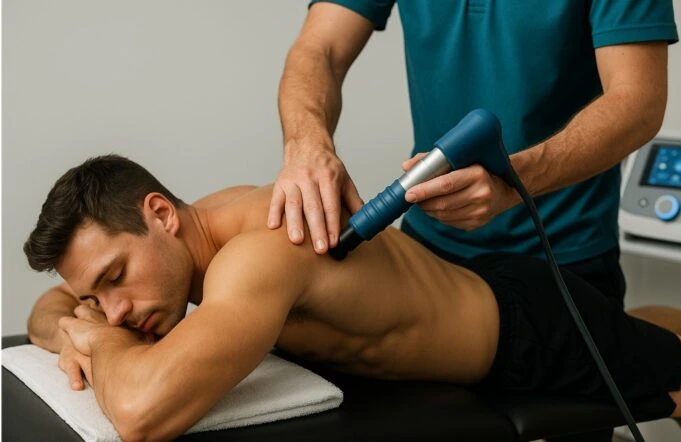Every athlete—whether professional or amateur—understands that physical conditioning, endurance, and performance rely heavily on recovery and injury prevention. But even the most rigorous training regimes and proper warm-ups cannot fully eliminate the risk of injuries, muscle fatigue, or chronic joint pain. This is where acoustic therapy, a non-invasive recovery method using sound waves, has emerged as a game-changing solution in the world of sports rehabilitation.
Acoustic treatments—also known as shockwave therapy—are becoming increasingly popular among athletes seeking quicker, drug-free recovery from injuries. These treatments help stimulate tissue regeneration, reduce inflammation, and alleviate pain at the source, allowing athletes to return to their sport faster and stronger.

What Is Acoustic Therapy?
Acoustic therapy involves the use of focused sound waves delivered to affected muscles, tendons, and joints. These sound waves penetrate deep into soft tissue, stimulating cellular repair and increasing blood flow. The process supports natural healing mechanisms within the body and promotes faster recovery from both acute and chronic injuries.
Because it is non-invasive, acoustic therapy eliminates the need for surgery or long-term medication use. Most importantly, it targets the underlying cause of pain, not just the symptoms—helping athletes regain optimal performance while avoiding drug-related side effects or prolonged rest periods.
How Acoustic Treatments Support Athletic Recovery
Acoustic therapy works by sending high-energy acoustic pulses into injured or inflamed tissue. These pulses trigger a response at the cellular level that accelerates tissue repair, boosts collagen production, and reduces localized inflammation.
For athletes, the benefits are clear:
- Faster recovery from strain or overuse injuries
- Pain relief without medication
- Improved mobility and performance
- Minimal downtime post-treatment
- Safe, non-surgical therapy for chronic pain
Unlike traditional methods that may require rest or pharmaceuticals, acoustic therapy sessions are short, effective, and allow most athletes to continue training the same day.
Common Sports Injuries Treated with Acoustic Therapy
Acoustic therapy is used to treat a wide range of sports-related injuries and chronic conditions that affect soft tissue and joints. Some of the most commonly treated include:
- Plantar fasciitis (heel pain)
- Tennis elbow or golfer’s elbow
- Achilles tendinopathy
- Hamstring strains
- Shoulder tendon injuries
- Shin splints and stress-related injuries
By addressing both inflammation and tissue damage, acoustic therapy helps heal injuries that are often slow to respond to conventional treatments like ice therapy, rest, or even massage.
Why Athletes Prefer Acoustic Therapy Over Traditional Methods
Athletes today are choosing acoustic therapy over traditional methods for several compelling reasons. It’s:
- Non-invasive
- No medication required
- No surgical intervention
- No extended recovery period
- Clinically proven for sports rehabilitation
Unlike cold packs or topical solutions that offer temporary relief, acoustic therapy works at a deeper level, targeting the real cause of pain. This allows athletes to recover not only faster but also more sustainably, reducing the risk of re-injury.
For professionals balancing tight competition schedules, a treatment that fits into a 20-minute session without downtime is ideal.
What to Expect During an Acoustic Therapy Session
An acoustic therapy session is typically fast, lasting between 15 to 20 minutes. A trained therapist uses a handheld device that emits high-frequency sound waves to the affected area. Athletes usually describe the sensation as gentle tapping or mild pressure, but it’s generally painless.
Most people do not experience discomfort after treatment and can resume physical activity shortly afterward. However, depending on the severity of the injury, multiple sessions may be required for full recovery.
Key Tips Before Starting Acoustic Therapy
Before starting any acoustic therapy program, it’s crucial to consult a sports medicine therapist or certified physiotherapist. Not every injury is suited for this type of treatment, and a professional evaluation ensures proper diagnosis and care. Here are a few important guidelines to follow:
- Work only with qualified professionals trained in acoustic or shockwave therapy.
- Don’t skip warm-ups and cool-downs—they’re essential for injury prevention.
- Stay consistent with your therapy sessions for the best outcomes.
- Listen to your body—pain is a signal, not a challenge to overcome recklessly.

Final Thoughts: Smarter Recovery, Better Performance
Today’s athletes require fast, safe, and effective recovery methods that allow them to continue pushing their limits without compromising their health. Acoustic therapy has proven to be a powerful tool in sports recovery, offering long-term benefits without the drawbacks of surgery or pharmaceutical interventions.
By embracing acoustic therapy, athletes can recover smarter, reduce pain more efficiently, and maintain peak performance with fewer setbacks. As part of a balanced recovery plan, it’s not just a modern trend—it’s a lasting solution in sports health.

